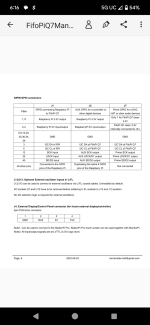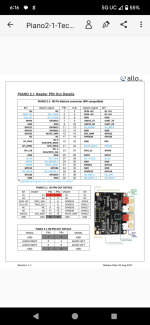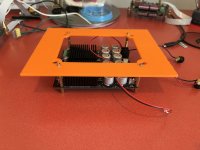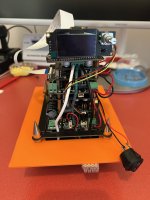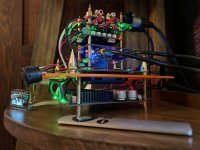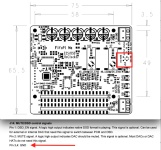I have read that RPi4 don’t need them. Maybe use taller standoffs between the RPi and the FIFO or add a little nut underneath the stand-off to give it more height.Hello everybody
I have just built a streamer with RPi4 + FIFOPi Q7 + TransportPi MKII.
My problem is that the heatsink on the Pi4 touches the bottom of the Q7!
How can I solve this? Do I even need heatsink on Pi4? It is quite hot because it runs 24/7.
Or you could try a ShieldPiProMkii between the Pi and FIFO. It has additional clearance exactly for this purpose and will reduce any noise from the pi.Hello everybody
I have just built a streamer with RPi4 + FIFOPi Q7 + TransportPi MKII.
My problem is that the heatsink on the Pi4 touches the bottom of the Q7!
How can I solve this? Do I even need heatsink on Pi4? It is quite hot because it runs 24/7.
ReceiverPiProII and MonitorPiPro together in a single DAC stack. 😜😎
I have 2 inputs running optical and rca from same source. Switch from the remote is seamless with nary a pop.

I would love some feedback on this build. Shortened up the power cables feeding the analogue stage.
I made a plate on my 3D printer to separate the LinearPi Duo and the DAC stack. Are they too close??? I don’t really feel heat over the linearPi duo heat sinks???
I have 2 inputs running optical and rca from same source. Switch from the remote is seamless with nary a pop.
I would love some feedback on this build. Shortened up the power cables feeding the analogue stage.
I made a plate on my 3D printer to separate the LinearPi Duo and the DAC stack. Are they too close??? I don’t really feel heat over the linearPi duo heat sinks???
Attachments
Last edited:
@fusion360guy
That's really great. MonitorPiPro makes the ReceiverPiPro II working full function.
I'll test my new ES9038Q2M Dual Mono II DAC this week.
That's really great. MonitorPiPro makes the ReceiverPiPro II working full function.
I'll test my new ES9038Q2M Dual Mono II DAC this week.
@iancanada cool. What is main differences between dualmonoplus and dualmono II?
Here could be some new improvements to the ES9038Q2M Dual Mono MKII, more information will be posted later
1. Bigger PCB size and bigger inner grounding shield areas
2. Enhanced local power supply low noise filtering networks to improve sound quality even more
3. Moves power supply connects to the side edge of the PCB for a more organized configuration.
4. With power supply configuration jumpers to either share one great ultra-low ESR power supply (such as a UcPure III 3.3V) or have separated power supplies
5. Software compatible with Plus
6. Better manufacturer quality
7. Can use Audiophonics ESS9038Q2M Linux driver for better performance when works with the new MonitorPiPro as the controller
8. High quality U.FL MCLK connectors at both top and bottom side of the PCB makes it possible to use shorter coaxial clock cable
9. Has mount holes to install the new low cost great sound quality balanced resistor I/V board
Ian
1. Bigger PCB size and bigger inner grounding shield areas
2. Enhanced local power supply low noise filtering networks to improve sound quality even more
3. Moves power supply connects to the side edge of the PCB for a more organized configuration.
4. With power supply configuration jumpers to either share one great ultra-low ESR power supply (such as a UcPure III 3.3V) or have separated power supplies
5. Software compatible with Plus
6. Better manufacturer quality
7. Can use Audiophonics ESS9038Q2M Linux driver for better performance when works with the new MonitorPiPro as the controller
8. High quality U.FL MCLK connectors at both top and bottom side of the PCB makes it possible to use shorter coaxial clock cable
9. Has mount holes to install the new low cost great sound quality balanced resistor I/V board
Ian
@WladimirMXPHello friends,
wow didn't expect so many questions, I'll try to answer them.
The tower consists of:
PurePi
Rpi 3b (non-plus, just v1.2)
3mm copper cooling/shielding plate
Now onto Ians' boards:
ShieldPi Pro
Isolator II
FifoPiMa with Accus
Teradak shielding/filtering board
TransportPi AES
and obviously UcConditioner
DC cables are OCC copper/silver NEOTECH CU-AG-20-20 and now testing Mundorf Pure Silver/Gold 18AWG.
Plus there are some more important tweaks thorough and special care went to vibration isolation/absorption.
Also as @badd99 pointed out, Gentooplayer with Diretta is an important piece of it as well, especially when tweaked with kernel selection and other more tweaky tweaksBenefits of having Diretta is like instantly having the best LAN cable out there and btw Diretta is free for playing redbook format. Other than an endpoint like this (or any other Rpi), you just need to set up a second source PC or RPi, connect those two on your network or directly as an server ("host") & endpoint ("target") and play

Could you please provide Teradak shielding/filtering board link and more details on that? how is this supported in between?
After having ShieldPi Pro, do we still need shielding plate? will that be additional support?
Thanks
Hier kunnen enkele nieuwe bronnen aan de ES9038Q2M Dual Mono MKII zitten, meer informatie zal later worden gepost
1. Grotere PCB-afmetingen en grotere binnenste aardingsschermgebieden
2. Verbeterde lokale stroomvoorziening, geluidsarme filternetwerken om de geluidskwaliteit nog verder te verbeteren
3. Verplaats de voeding, wordt aangesloten op de zijkant van de printplaat voor een meer georganiseerde configuratie.
4. Met voedingsconfiguratiejumpers om één geweldige ultra-lage ESR-voeding te delen (zoals een UcPure III 3,3V) of gescheiden voedingen te hebben
5. Software-compatibel met Plus
6. Betere fabriekskwaliteit
7. Kan de Audiophonics ESS9038Q2M Linux-driver gebruiken voor betere prestaties wanneer deze werkt met de nieuwe MonitorPiPro als controller
8. Hoogwaardige U.FL MCLK-connectoren aan zowel de boven- als onderkant van de printplaat maken het mogelijk kleinere coaxiale klokkabels te gebruiken
9. Heeft montagegaten om de nieuwe, goedkope, gebalanceerde I/V-weerstandskaart met uitstekende geluidskwaliteit te installeren
Ian
Hallo Ian, kan het de functies die HQPlayer biedt volledig ondersteunen? En hoe zit het met native dsd-ondersteuning?Hier kunnen enkele nieuwe verbeteringen aan de ES9038Q2M Dual Mono MKII zitten , meer informatie zal later worden gepost
1. Grotere PCB-afmetingen en grotere binnenste aardingsschermgebieden
2. Verbeterde lokale stroomvoorziening, geluidsarme filternetwerken om de geluidskwaliteit nog verder te verbeteren
3. Verplaatst de voeding, wordt aangesloten op de zijkant van de printplaat voor een meer georganiseerde configuratie.
4. Met voedingsconfiguratiejumpers om één geweldige ultra-lage ESR-voeding te delen (zoals een UcPure III 3,3V) of gescheiden voedingen te hebben
5. Software compatibel met Plus
6. Betere fabriekskwaliteit
7. Kan de Audiophonics ESS9038Q2M Linux-driver gebruiken voor betere prestaties wanneer deze werkt met de nieuwe MonitorPiPro als controller
8. Hoogwaardige U.FL MCLK-connectoren aan zowel de boven- als onderkant van de printplaat maken het mogelijk kortere coaxiale klokkabels te gebruiken
9. Heeft montagegaten om de nieuwe, goedkope, gebalanceerde I/V-weerstandskaart met uitstekende geluidskwaliteit te installeren
Ian
Rgrds Jan
I am reading and reading, but can't quite get what is possible here.
I have some parts in a basic build. But want to start a project for a more optimal solution for high end audio.
What I have:
IAN CANADA STATIONPI
IAN CANADA FIFOPI Q3 ULTIMATE FIFO
IAN CANADA TRANSPORTPI
IAN CANADA RECLOCKPI
IAN CANADA Dual Mono ES9038Q2M DAC HAT
IAN CANADA LifePO4 Mini 3.3V
RPi3b 16 GB
RPi4b 4GB
Next solution will be a "no compromise" Roon capable streamer transport. I want to test how far this can go based on RPi, without throwing away money I don't get SQ back from.
Requirements. Min 384KHz PCM and DSD256 over I2S. Preferrably higher. Using a Roon server with a library of DSD256 and some DSD512 files.
Native resolution to the DAC.
Have decided to use an external DAC. Use a Denafrips Pontus II today and may upgrade to PSAudio DAC MKII, Terminator+ or others with multiple I2S inputs.
Reading the threads here it seems like there is no RPi solution capable of DSD256/DSD512 over I2S. If not, I will not start this project.
If possible, what do I need? first a POC, after that all in with power supplies and cabinet(s)
I have some parts in a basic build. But want to start a project for a more optimal solution for high end audio.
What I have:
IAN CANADA STATIONPI
IAN CANADA FIFOPI Q3 ULTIMATE FIFO
IAN CANADA TRANSPORTPI
IAN CANADA RECLOCKPI
IAN CANADA Dual Mono ES9038Q2M DAC HAT
IAN CANADA LifePO4 Mini 3.3V
RPi3b 16 GB
RPi4b 4GB
Next solution will be a "no compromise" Roon capable streamer transport. I want to test how far this can go based on RPi, without throwing away money I don't get SQ back from.
Requirements. Min 384KHz PCM and DSD256 over I2S. Preferrably higher. Using a Roon server with a library of DSD256 and some DSD512 files.
Native resolution to the DAC.
Have decided to use an external DAC. Use a Denafrips Pontus II today and may upgrade to PSAudio DAC MKII, Terminator+ or others with multiple I2S inputs.
Reading the threads here it seems like there is no RPi solution capable of DSD256/DSD512 over I2S. If not, I will not start this project.
If possible, what do I need? first a POC, after that all in with power supplies and cabinet(s)
- Home
- Source & Line
- Digital Line Level
- Asynchronous I2S FIFO project, an ultimate weapon to fight the jitter
